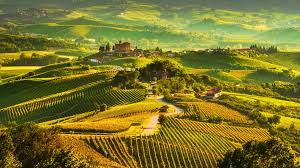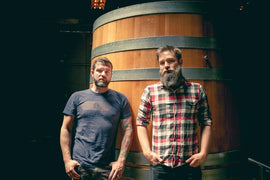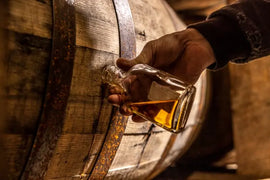Wines of Piedmont
Piedmont is Italy's westernmost region. It borders on Switzerland and France, and is hemmed in by the Alps and Apennines. Piedmont, in Italian, means “at the foot of the mountain”. With 46 different DOC and four DOCG areas, it is renowned for its famous wine grapes like Nebbiolo, Barbera, and Dolcetto, but it is also home to many lesser-known, yet fascinating grape varieties. These often thrive in specific subregions and offer unique flavors and historical significance. Most of Piedmont’s wines are produced on family estates made up of relatively small parcels of land. For craftsmanship, respect for tradition and devotion to native vines in their historical habitat, the Piedmontese have no rivals in Italy.
Our first wine is a Grignolino, a red grape native to the Piedmont region of northern Italy, particularly in the provinces of Asti and Alessandria. The name "Grignolino" is believed to derive from the Piedmontese word "grignole," which refers to the grape's many seeds. It is known for producing light-bodied, aromatic red wines with a distinct character. The grapes have relatively thin skins, which contribute to the light color of the wine. They also have naturally high acidity, making them fresh and vibrant. Despite their light body, Grignolino wines often have notable tannins due to the high number of seeds in the grapes. Grignolino is a challenging grape to grow due to its susceptibility to mildew and the need for careful vineyard management, but it thrives in the sandy, calcareous soils of Piedmont's rolling hills. Grignolino is a wonderful choice for wine lovers seeking something distinctive and off the beaten path, especially if you're a fan of delicate yet characterful reds.
Our second wine, a Vespolina, is a lesser-known red grape primarily grown in the Piedmont region of northwestern Italy. The name "Vespolina" is thought to derive from the Italian word vespa (wasp), possibly because the grapes' sweetness attracts wasps during ripening. It plays a supporting role in wine blends, though it is occasionally vinified as a varietal wine. Vespolina wines are known for their bright red fruit flavors, including cherries, raspberries, and red currants, along with floral and spicy notes. They often exhibit a touch of white pepper and herbal nuances. The wines tend to have moderate tannins and vibrant acidity, making them fresh and approachable, so you should drink your Vespolina while your Nebbiolo ages in the cellar.
Last but not least, is the distinguished Nebbiolo, which is the base for the famed Barolo, Barbaresco and Gattinara. Its name derives from the word nebbia, or fog, because of a velvety, whitish coating over its berries. In addition, it grows in an area where, at ripening time in September, heavy morning fog is a given and the humidity that it provides gives the grapes an ideal habitat. Over 90 percent of Piedmont’s Nebbiolo wines come from the southern part of the region, the Alba area, which includes the Langhe hills and the Roero hills. Nebbiolo wines made outside of the Barolo and Barbaresco zones have such names as Nebbiolo d’Alba, Nebbiolo delle Langhe and Nebbiolo di Piemonte. In general, they are lighter-bodied, less serious wines than Barolo and Barbaresco, but have the advantage of being ready to drink sooner and being less expensive
Cheers,
Carrie Upson- General Manager/Wine Buyer
|
La Casaccia 'Il Poggetto' Grignolino del Monferrato Casalese |
|
|
Region / Country of Origin: Monferrato DOC, Piedmont, Italy |
About the winery: In the Monferrato Casalese village of Cella Monte, agricultural science majors, Giovanni and Elena Rava, took over La Casaccia in 2001 and converted it to organic farming. A remarkable ecosystem of natural and human-made biodiversity surrounds the vineyards. Vines are planted on white chalk with layers of eroded sandstone and surrounded by untamed forests, wild fruit and nut trees. Their traditionally crafted wines are lifted, complex and filled with the humble yet exuberant character of la familia. Winemaking Notes: Poggeto' is destemmed and naturally fermented in fiberglass tanks for 3-4 days on skins with 2-3 daily gentle pump-overs (like rain, not a stream of wine), then the free-run wine is drawn off (without pressing) to finish fermentation in large steel vats (50-100 hl) at 20-22°C maximum. It’s then aged on fine lees for 2 months, racked off the lees and aged in steel until bottling between May to July. It’s fined with bentonite (natural clay) and filtered before bottling. Tasting Notes: delicate aromas and flavors of red berries (like strawberry and cherry), white pepper, rose petals, and sometimes earthy or herbal notes. The zippy acidity of the Grignolino is a perfect foil for ingredients with some tartness themselves, like the olives and the feta cheese. Serving an acidic wine with acidic components in a dish softens the tang in both the wine and the food, making the wine feel rounder and more lush on the palate, and making the olives taste fruitier and the cheese taste even creamier. |
|
Winemaker: Giovanni Rava |
|
|
Price per bottle / Price per case: $22.99 btl/ $248.29 |
|
|
Suggested Food Pairing: Spaghetti with Tomatoes, Fresh Herbs, Black Olives, and Feta Cheese, Vegetarian dishes, particularly those featuring tomatoes or roasted vegetables, White meats like chicken and turkey. |
|
|
Davide Carlone Vespolina Colline Novaresi 2022 |
|
|
Region / Country of Origin: Colline Novaresi DOC, Piemonte, Italy |
About the winemaker: Davide Carlone is one of the most serious and important winegrowers in Piedmont. Based in Boca, a small appellation in Alto Piemonte, at the foothills of the Italian Alps, Davide’s focus is on Nebbiolo and the local supporting cast, Croatina, Vespolina, and Erbaluce. His vineyards are farmed organically and biodynamically and are surrounded by forest which helps promote biodiversity. In the cellar, he works mostly with larger old oak botti and some stainless steel. Davide is well-known in the region for his extreme attention to detail in the vineyards; he stands as a model for the surrounding appellations. About the grape: One of the genetic parents of Nebbiolo, Vespolina performs best in drier, well-drained soils (the sand and gravel of Boca are its friends), has bright acidity, usually 1-2g/L higher than Nebbiolo, a lower pH, and a beautifully original and noble aroma of white pepper (due to the rotundone molecule, which is found in Syrah or Grüner Veltliner, and in white and black pepper). Tasting Notes: It has Nebbiolo's spicy characteristics, although its tannins tend to be softer. It is an intriguing combination of dark spices, pepper, cardamom, cloves and ginger. It has redcurrant, blueberry and raspberry fragrances with subtle and delicate floral notes of iris. The taste is fresh and spicy with a warm aftertaste. |
|
Winemakers: Davide Carlone |
|
|
Price per bottle / Price per case: $29.99/btl $323.89/cs |
|
|
Suggested Food Pairing: Cured meats and salami, Grilled or roasted poultry, Tomato-based pasta dishes, Semi-hard cheeses like Fontina. |
|
|
Mauro Marengo Ravera Barolo 2019 |
|
|
Region / Country of Origin: Barolo DOCG, Piedmont, Italy Barolo DOCG, Piedmont, Italy |
About the Winemaker: Once the Marengo family's technical direction was given to Daniele at age twenty-two, his personal taste and style of wines led him to pursue freshness over power and ripeness, and to highlight their Novello-based , high-altitude vineyards. They turned their attention to soil health and the incorporation of organic farming, the cellar work was gentler - new techniques were employed and they began to harvest earlier. While it’s typical for a Piemontese winemaking family to pass the winery to the next generation, what makes the Marengos unique is how early they began to pass the torch onto their children. Daniele put it well, “My father was very forward-thinking and created a true generational transition, leaving my sisters and me the possibility of embarking on a new path, while always remaining by our side, listening to our ideas and trying to understand them without putting ‘spokes’ in them.” About the Winemaking: Naturally fermented with a skin maceration time of 35-38 days. (Ravera may also undergo a submerged cap fermentation, but this depends on the year.) Three daily pumpovers in the beginning of fermentation and one or none in the later maceration period. After fermentation, it is racked once or twice prior to going into 25hl Slavonian oak botte for 20-22 months and an additional two in steel. Tasting Notes: The 2019 Ravera was aromatically tight at first, which is often a good indicator of stability for cellar aging and provides the right lengthy pacing for a nice long conversation over dinner. However, it loosens quickly to reveal its kaleidoscopic aromas of violets, lavender, orange peel, Persian mulberry, purple plum, and purple wine grapes, with spice, tar, leather, porcini, and wet forest. The tannins build as it opens and works into beautiful harmony and fluidity. |
|
Winemaker: Daniele Marengo |
|
|
Price per bottle / Price per case: $77.99/btl $842.29 case |
|
|
Suggested Food Pairing: Risotto with truffles, Grana Padana or Castelmagno cheese, Agnolotti filled with braised meat, Ribeye steak, Venison stew. |
|





